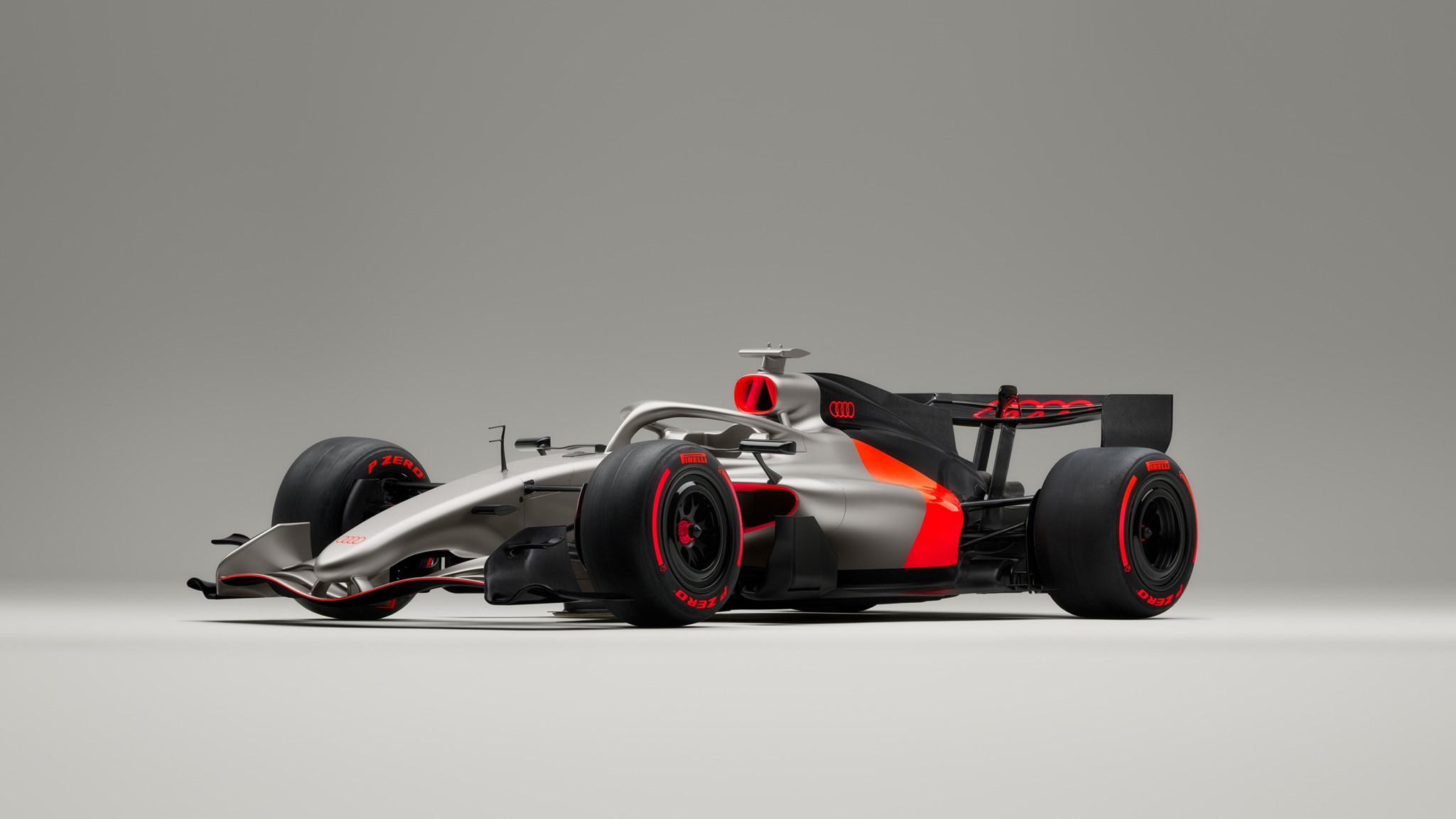► Audi F1 launched in Munich
► New ‘car’ on show
► What to expect from the new team in 2026
Audi’s journey to Formula One has officially begun. An event in Munich has seen the world get its first glimpse of Ingolstadt’s 2026 challenger. At the same event, we also got a much better idea of how it’s all going to work.
The project will be led by an all-star cast that you may have seen before: ex-Ferrari boss Mattia Binotto is heading up the F1 project as a whole, but it’ll be ex-Red Bull man Jonathan Wheatley that’ll sit on the pit wall and control the trackside operations at races. Think of the current Zak Brown, Andrea Stella setup at McLaren.
Of course, Audi’s main bosses will be close by, so the whole thing will be overseen by Audi CEO Gernot Döllner, with chief creative officer Massino Frascella also on hand for art direction – the man responsible for the new F1 livery and also the dramatic Audi Concept C.
Audi’s powertrain will be assembled in Neuberg,Germany, though the chassis at least will be built at the brand’s newly acquired Sauber site in Hinwil, Switzerland. Sauber has a Bicester site in the UK too, but it doesn’t seem to play a huge role at this stage. Binotto’s ability to carefully synchronise its powertrain and chassis sites will be key to Audi’s success in F1 over the next years.
Audi is around six weeks away from its first public winter test, and that means we’ve seen nothing more than a dummy car – but it’s still interesting to see the titanium silver (also seen on the Concept C) and Audi red livery that the team has gone for. Those that follow Audi’s prototypes will notice it’s a mixture of the brand’s standard colours and the vibrant ones they use on their prototype cars. The new titanium colour, stands for ‘performance and technical precision,’ apparently.
Expect more sponsors, vastly different aero and at least a big BP badge (the team’s official fuel sponsor) when it arrives for real in 2026. It’ll be driven by the two existing Kick Sauber drivers, Nico Hülkenberg and Gabriel Bortoleto.
‘You can sense that something big is happening here,’ said Hulkenberg. ‘The team’s energy and ambitions are impressive, and the project’s positive atmosphere is truly tangible. This is the beginning of a long journey, and that’s exactly what motivates me. 2026 will be a reset for everyone: new rules, new cars, and new opportunities.’
Audi has picked an interesting time to join: 2026 will see new rules that feature a greater focus on the electric element of F1, as well as a greater freedom on the fuel side. The hybrid element will be responsible for 350kW of energy next year (double that allowed so far) and the MGU-H – which captures energy and reduces turbo lag – is also out. The result is a more powerful and tricky-to-use powertrain but one that should be cheaper to make: the powertrain budget is just €180 million (around £160m) this time.
Audi’s history in motorsport needs no introduction, but it reckons its biggest challenge is the ICE component rather than the electric bits. Time in the Formula E championship and competing in Dakar means Neuberg is well-versed in creating high performance electric solutions. More alien is the 50-100 ICE engines it’ll need to build and develop every year – starting around six years after the competition.
At the same time the freedom the sport’s fuel partners will have is also going up: alongside a push towards more sustainable fuels, there’s now more play in the fuel regulations. Audi has partnered with BP and is the only team to do so; and that could be good news or bad news. There’ll be less data compared with those fuel brands that supply multiple teams, but BP will be able to create a fuel that fits perfectly to the Audi’s ICE components.
With all the above in mind, Audi is expecting to play the long game. ‘Audi’s Formula 1 story is just beginning, but motorsport has always been part of who we are,’ said Dollner. ‘From the Auto Union Silver Arrows of the 1930s to dominance in touring cars, rallying, and hybrid triumphs at the Le Mans 24 Hours, whenever Audi entered a racing series, success followed.’ It may need to wait a little while, first.
It’s a view shared by the F1 staff too: ‘This is the most exciting project in motorsports, if not in all sports. The goal is clear: to fight for championships by 2030,’ said Binotto. ‘That journey takes time, the right people and a mindset of continuous improvement.’
And Wheatley too: ‘This journey is not just about the destination but about engaging with the people who make every step possible,’ he added. ‘It is about your mindset, focus, resilience and confidence without complacency. We will face setbacks, but each one will be a learning experience that will lead to new strength.’
We’ll update this article when we know more.
Curtis Moldrich is CAR magazine’s Digital Editor and has worked for the brand for the past five years. He’s responsible for online strategy, including CAR’s website, social media channels such as X (formerly Twitter) and Facebook, and helps on wider platform strategy as CAR magazine branches out on to Apple News+ and more.
By Curtis Moldrich
CAR’s Digital Editor, F1 and sim-racing enthusiast. Partial to clever tech and sports bikes
© 1962-2025 Bauer Media Group
Bauer Media Group consists of: Bauer Consumer Media Ltd, Company number 01176085; Bauer Radio Limited,
Company number: 1394141; Registered office: Media House, Peterborough Business Park, Lynch Wood, Peterborough PE2 6EA and H Bauer Publishing, Company number: LP003328;
Registered office: The Lantern, 75 Hampstead Road, London NW1 2PL
All registered in England and Wales. VAT no 918 5617 01
H Bauer Publishing are authorised and regulated for credit broking by the FCA (Ref No: 845898)












